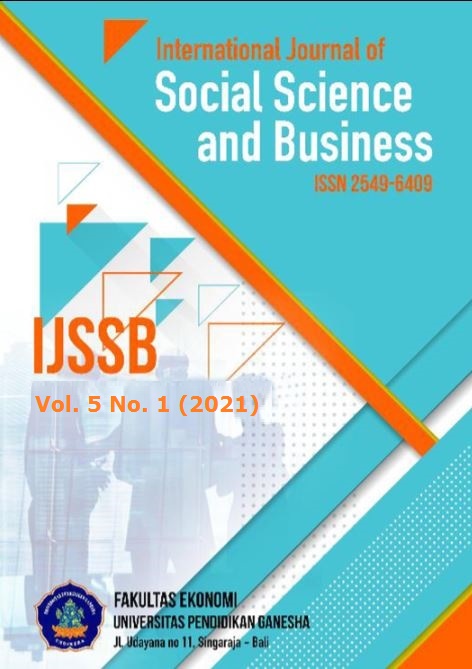Internet Banking Service Quality: Building Satisfaction and Customer Trust
DOI:
https://doi.org/10.23887/ijssb.v5i1.31861Keywords:
Building Satisfaction, Costumer TrustAbstract
This study aims to analyzes how IBSQ variables influence customer satisfaction and trust in state-owned banks in Jember Regency. The sample in this study amounted to 150 with a purposive sampling approach with data collection through questionnaires. The analysis in this study used a structural equation model (SEM-PLS). Research conducted proves that the IBSQ variables, namely personal needs, site organization, user-friendliness, efficiency, responsiveness, reliability, customer satisfaction, and customer satisfaction, affect trust. The six IBSQ variables have their variations and effects on customer satisfaction. In this study, the most significant coefficient that affects satisfaction is reliability. Reliability as the variable with the largest coefficient can be interpreted as system reliability and security, which are the top priority and guarantees in IBSQ. This study's findings indicate that it is essential for banks to improve service quality sustainably to generate competitive and consistent advantages over time. This study's overall results suggest that IBSQ as part of the banking business plays an essential role in forming customer satisfaction. Satisfaction is critical and requires consistent effort and strategy in achieving it.
References
Alnaser, F. M. I., Ghani, M. A., & Rahi, S. (2018). Service quality in Islamic banks: The role of PAKSERV model, customer satisfaction and customer loyalty. Accounting, 4(2), 63–72. https://doi.org/10.5267/j.ac.2017.8.001.
Amin, M. (2016). Internet banking service quality and its implication on e-customer satisfaction and e-customer loyalty. International Journal of Bank Marketing, 34(3), 280–306. https://doi.org/10.1108/IJBM-10-2014-0139.
Ariff, M. S. M., Yun, L. O., Zakuan, N., & Ismail, K. (2013). The Impacts of Service Quality and Customer Satisfaction on Customer Loyalty in Internet Banking. Procedia - Social and Behavioral Sciences, 81, 469–473. https://doi.org/10.1016/j.sbspro.2013.06.462.
Berezina, K., Cobanoglu, C., Miller, B. L., & Kwansa, F. A. (2012). The impact of information security breach on hotel guest perception of service quality, satisfaction, revisit intentions and word-of-mouth. International Journal of Contemporary Hospitality Management, 24(7), 991–1010. https://doi.org/10.1108/09596111211258883.
Boonlertvanich, K. (2019). Service quality, satisfaction, trust, and loyalty: the moderating role of main-bank and wealth status. International Journal of Bank Marketing, 37(1), 278–302. https://doi.org/10.1108/IJBM-02-2018-0021.
Chu, P. Y., Lee, G. Y., & Chao, Y. (2012). Service quality, customer satisfaction, customer trust, and loyalty in an e-banking context. Social Behavior and Personality, 40(8), 1271–1284. https://doi.org/10.2224/sbp.2012.40.8.1271.
Evans, M., Jamal, A., & Foxall, G. (2010). Consumer Behaviour. In Behaviour (Vol. 29, Issue 1). https://doi.org/papers2://publication/uuid/BE8792F6-01FC-4338-8046-B7414F15446B.
Famiyeh, S., Asante-Darko, D., & Kwarteng, A. (2018). Service quality, customer satisfaction, and loyalty in the banking sector. International Journal of Quality & Reliability Management, 35(8), 1546–1567. https://doi.org/10.1108/ijqrm-01-2017-0008.
Ga, J. C., & Sa, M. (2005). Effects of service quality dimensions on behavioural purchase intentions. 1991. https://doi.org/10.1108/09604520710735164.
Ghane, S., Fathian, M., & Gholamian, M. R. (2011). Full relationship among e-satisfaction, e-trust, e-service quality, and e-loyalty: The case of Iran e-banking. Journal of Theoretical and Applied Information Technology, 33(1), 1–6.
Ghozali, I. (2014). Structural Equation Model Metode Alternatif dengan Partial Least Squares (PLS) (4th ed.). Badan Penerbit Universitas Diponegoro.
Hamid, R. S., & Anwar, S. M. (2019). STRUCTURAL EQUATION MODELING ( SEM ) BERBASIS VARIAN Konsep Dasar dan Aplikasi Program Smart PLS 3.2.8 dalam Riset Bisnis (I, Issue Juni). Pt. Inkubator Penulis Indonesia.
Hammoud, J., Bizri, R. M., & El Baba, I. (2018). The Impact of E-Banking Service Quality on Customer Satisfaction: Evidence From the Lebanese Banking Sector. SAGE Open, 8(3), 1–12. https://doi.org/10.1177/2158244018790633.
Herington, C., & Weaven, S. (2009). E-retailing by banks: E-service quality and its importance to customer satisfaction. European Journal of Marketing, 43(9), 1220–1231. https://doi.org/10.1108/03090560910976456.
Ho, C. T. B., & Lin, W. C. (2010). Measuring the service quality of internet banking: Scale development and validation. European Business Review, 22(1), 5–24. https://doi.org/10.1108/09555341011008981.
Junida, A. I. (2020). BRI catat kenaikan pengguna internet banking hingga 24 juta nasabah. Antaranews.Com.
Kotler, P., Kartajaya, H., & Setiawan, I. (2017). Marketing 4.0 Moving from Tradisional to Digital. Wiley.
Kotler, P., & Keller, K. L. (2016). Marketing Management. In Pearson Education Limited (15e ed., Vol. 15E, Issue 4). Pearson. https://doi.org/10.1080/08911760903022556.
Liébana-Cabanillas, F., Muñoz-Leiva, F., & Rejón-Guardia, F. (2013). The determinants of satisfaction with e-banking. Industrial Management and Data Systems, 113(5), 750–767. https://doi.org/10.1108/02635571311324188.
Manrai, L. A., & Manrai, A. K. (2007). A field study of customers’ switching behavior for bank services. Journal of Retailing and Consumer Services, 14(3), 208–215. https://doi.org/10.1016/j.jretconser.2006.09.005.
Namahoot, K. S., & Laohavichien, T. (2018). Assessing the intentions to use internet banking: The role of perceived risk and trust as mediating factors. International Journal of Bank Marketing, 36(2), 256–276. https://doi.org/10.1108/IJBM-11-2016-0159.
Pakurár, M., Haddad, H., Nagy, J., Popp, J., & Oláh, J. (2019). The service quality dimensions that affect customer satisfaction in the Jordanian banking sector. Sustainability, 11(4), 1–24. https://doi.org/10.3390/su11041113.
Parasuraman, A., Zeithaml, V. A., & Berry, L. L. (1988). Servqual : A Multiple-Item Scale for Measuring Consumer Perceptions of Service Quality. Journal of Retailing, 64(1).
Patel, K. J., & Patel, H. J. (2018). Adoption of internet banking services in Gujarat. International Journal of Bank Marketing, 36(1), 147–169. https://doi.org/10.1108/ijbm-08-2016-0104.
Pollack, B. L. (2017). Effects of exit barriers on word of mouth activities. Journal of Services Marketing, 31(6), 512–526. https://doi.org/10.1108/JSM-01-2016-0024.
Rahi, S., Ghani, M. A., & Ngah, A. H. (2020). Factors propelling the adoption of internet banking: The role of e-customer service, website design, brand image and customer satisfaction. International Journal of Business Information Systems, 33(4), 549–569. https://doi.org/10.1504/IJBIS.2020.105870.
Raza, S. A., Umer, A., Qureshi, M. A., & Dahri, A. S. (2020). Internet banking service quality, e-customer satisfaction and loyalty: the modified e-SERVQUAL model. TQM Journal, 32(6), 1443–1466. https://doi.org/10.1108/TQM-02-2020-0019.
Shankar, A., & Jebarajakirthy, C. (2019). The influence of e-banking service quality on customer loyalty: A moderated mediation approach. International Journal of Bank Marketing, 37(5), 1119–1142. https://doi.org/10.1108/IJBM-03-2018-0063.
Suryaningsih, I. B., Nugraha, K. W. S., & Sukmalangga, A. Y. (2020). Reflection of Customer Experience and Destination Image of Tourist Trust through Satisfaction Mediation. Hasanuddin Economics and Business Review, 4(1), 1–6. https://doi.org/10.26487/hebr.v4i1.2329.
Tham, K. W., Dastane, O., Johari, Z., & Ismail, N. B. (2019). Perceived risk factors affecting consumers’ online shopping behaviour. Journal of Asian Finance, Economics and Business, 6(4), 246–260. https://doi.org/10.13106/jafeb.2019.vol6.no4.246.
Tjiptono, F., & Chandra, G. (2019). Service, Quality & Customer Satisfaction (5th ed.). ANDI.
Tjiptono, F., & Diana, A. (2020). Pemasaran. ANDI.
Wirtz, J., & Lovelock, C. (2018). Essentials of Service Marketing (3rd ed.). Pearson.
Yuan, Y., Lai, F., & Chu, Z. (2019). Continuous usage intention of Internet banking: a commitment-trust model. Information Systems and E-Business Management, 17(1). https://doi.org/10.1007/s10257-018-0372-4.











